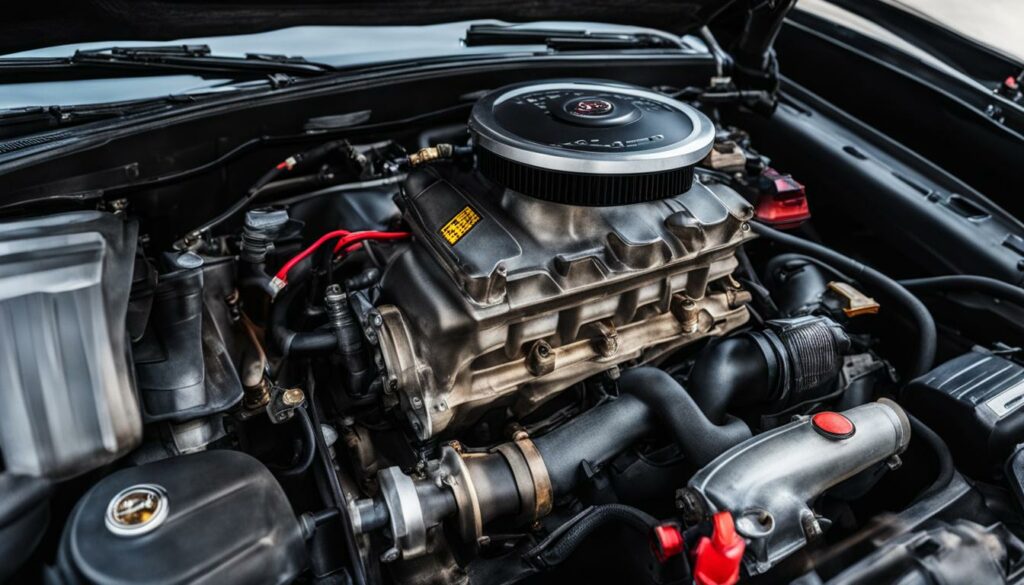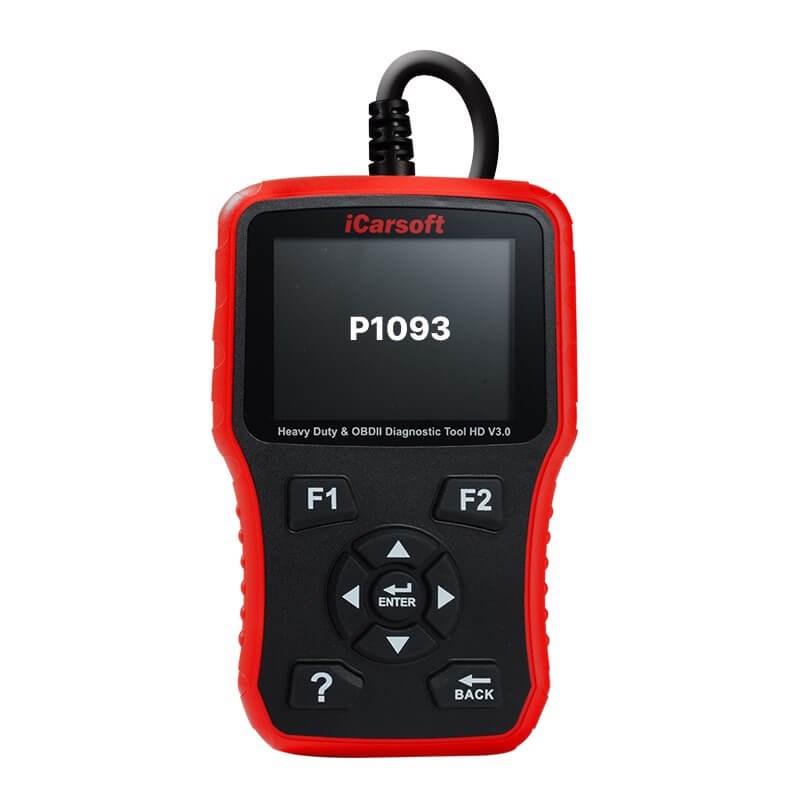P1093 – Fuel Trim Bank 1 Out of Range
POSTED IN pcodes
Welcome to our article on P1093 – Fuel Trim Bank 1 Out of Range. If you’re experiencing issues with your vehicle’s fuel trim, engine performance, or fuel efficiency, this diagnostic trouble code may provide some insight into the problem. Understanding the causes and symptoms of this code can help you address the issue and ensure optimal vehicle performance and fuel economy.
The fuel trim refers to the adjustment made to the fuel mixture in your vehicle’s fuel system. When the fuel trim for Bank 1 is out of range, it can lead to various complications, including poor engine performance and decreased fuel efficiency. Identifying and resolving this issue is crucial to maintaining the overall health of your vehicle.
Key Takeaways:
- P1093 – Fuel Trim Bank 1 Out of Range indicates an issue with the fuel trim for Bank 1 in your vehicle’s fuel system.
- Out-of-range fuel trim can negatively impact engine performance and fuel efficiency.
- Common causes of P1093 include issues with oxygen sensors, vacuum leaks, faulty fuel injectors, malfunctioning mass air flow sensors, or fuel pressure problems.
- Addressing symptoms promptly and following a systematic troubleshooting process can help identify and resolve the issue.
- Regular vehicle maintenance and attention to the fuel system can prevent the occurrence of P1093 and ensure optimal fuel efficiency.
Understanding P1093 – Fuel Trim Bank 1 Out of Range
In the world of automotive diagnostics, the P1093 code is one that raises eyebrows and demands attention. This diagnostic trouble code specifically relates to the fuel trim adjustment for Bank 1 of a vehicle’s fuel system. But what exactly does that mean, and why is it important?
The fuel trim, in simple terms, refers to the amount of adjustment made to the fuel mixture in order to achieve optimal engine performance and fuel efficiency. It is a crucial aspect of a vehicle’s fuel system, as it ensures that the engine receives the right fuel-to-air ratio for combustion.
When the fuel trim for Bank 1 is out of range, it indicates that the adjustments made to the fuel mixture are not within the specified limits. This can have various negative effects on a vehicle’s performance, efficiency, and emissions.
Buy tested tuning file for Adblue / EGR / DPF / Adblue off now!
To put it into perspective, let’s consider some of the consequences associated with a fuel trim bank 1 that is out of range:
- Poor Engine Performance: An incorrect fuel mixture can lead to sluggish acceleration, rough idling, and overall decreased engine performance. This can negatively impact the driving experience and may even cause potential safety concerns.
- Decreased Fuel Efficiency: When the fuel-to-air ratio is not optimized, fuel consumption tends to increase. This means that the vehicle will cover fewer miles per gallon of fuel, ultimately leading to higher fuel costs.
- Potentially Harmful Emissions: Not only does an imbalanced fuel mixture affect performance and fuel efficiency, but it can also have a detrimental impact on emissions. A fuel trim bank 1 out of range can contribute to higher levels of pollutants being released into the environment.
Understanding the meaning and severity of the P1093 code is crucial in order to effectively troubleshoot and resolve the issue. By doing so, you can regain optimal engine performance, improve fuel efficiency, and reduce harmful emissions.
“A vehicle’s fuel trim plays a critical role in maintaining engine performance and efficiency. When the fuel trim for Bank 1 is out of range, it’s like having an orchestra conductor who isn’t quite in tune with the musicians. The result is a harmonious performance that falls flat.”
Next, let’s explore the various symptoms that may indicate a fuel trim bank 1 out of range in Section 3.

Symptoms of P1093 – Fuel Trim Bank 1 Out of Range
When your vehicle displays the P1093 – Fuel Trim Bank 1 Out of Range code, there are several symptoms that may indicate an issue with the fuel trim adjustment for Bank 1. It is important to be aware of these symptoms in order to promptly address and resolve the problem.
- Rough idling: One common symptom is rough idling, where the engine may feel like it’s shaking or vibrating more than usual when at a standstill. This can be especially noticeable when the vehicle is in gear.
- Hesitation or stumbling during acceleration: Another symptom is hesitation or stumbling during acceleration. You may experience a delay or lack of power when pressing the accelerator, or the vehicle may jerk or hesitate during acceleration.
- Decreased fuel efficiency: The P1093 code can also lead to decreased fuel efficiency. If you notice that your vehicle is using more fuel than usual and you are making more frequent trips to the gas station, it could be a result of the fuel trim adjustment issue.
- Illuminated check engine light: An illuminated check engine light is another possible symptom of P1093 – Fuel Trim Bank 1 Out of Range. The check engine light serves as a warning indicator for various issues, including fuel system problems.
The severity of these symptoms may vary depending on the specific vehicle and the extent of the fuel trim adjustment issue. However, it is important to address these symptoms promptly to prevent further damage to the vehicle and to maintain optimal fuel efficiency.

Common Causes of P1093 – Fuel Trim Bank 1 Out of Range
When encountering the P1093 – Fuel Trim Bank 1 Out of Range code, it is important to identify the underlying causes to effectively resolve the fuel trim adjustment problem. Several common causes include:
- Issues with the oxygen sensor before the catalytic converter: A faulty or contaminated oxygen sensor can provide inaccurate readings, leading to an out-of-range fuel trim for Bank 1.
- Vacuum leaks: Leaks in the intake manifold or vacuum hoses can result in unmetered air entering the engine, causing an imbalance in the fuel-air mixture and triggering the P1093 code.
- Faulty fuel injectors: Injectors that are clogged, leaking, or not delivering the correct amount of fuel can disrupt the fuel trim adjustment, leading to an out-of-range condition.
- Malfunctioning mass air flow sensor (MAF): A defective MAF sensor can inaccurately measure the amount of air entering the engine, causing improper fuel trim adjustments.
- Problem with fuel pressure in the fuel rail: Insufficient fuel pressure or a malfunctioning fuel pressure regulator can affect the fuel delivery system, resulting in an out-of-range fuel trim.
It is important to conduct a thorough diagnostic to determine the exact cause of the P1093 code. By addressing the underlying issues, such as repairing or replacing faulty components, it is possible to resolve the fuel trim adjustment problem and restore optimal engine performance and fuel efficiency.
“Identifying and resolving the common causes of the P1093 code is crucial to effectively troubleshoot and resolve the fuel trim adjustment problem.”
Troubleshooting Steps for P1093 – Fuel Trim Bank 1 Out of Range
When you encounter the P1093 – Fuel Trim Bank 1 Out of Range code, it is important to follow a systematic approach to troubleshooting. By following these steps, you can effectively identify and resolve the issue causing the fuel trim adjustment problem.
- Conduct a visual inspection: Start by visually inspecting the engine compartment and fuel system components for any obvious issues such as disconnected or damaged hoses, loose connections, or signs of leaks.
- Perform a comprehensive scan: Use a diagnostic tool to perform a comprehensive scan of the vehicle’s onboard computer system. This will help retrieve any additional fault codes that may provide further insight into the issue.
- Test the oxygen sensor: The oxygen sensor plays a crucial role in fuel mixture regulation. Perform a test to ensure that the oxygen sensor is functioning correctly and providing accurate readings.
- Check for vacuum leaks: Vacuum leaks can disrupt the air-fuel mixture and cause the fuel trim to go out of range. Use a smoke machine or other suitable methods to check for vacuum leaks and address any found.
- Test the mass air flow sensor: The mass air flow sensor measures the amount of air entering the engine. If it is faulty or dirty, it can affect fuel trim. Test the mass air flow sensor and clean or replace it if necessary.
- Check fuel pressure: Low or inconsistent fuel pressure can lead to fuel trim issues. Use a fuel pressure gauge to test the fuel pressure in the fuel rail and ensure it is within the manufacturer’s specified range.
By methodically addressing each of these potential causes, you can effectively troubleshoot and resolve the P1093 – Fuel Trim Bank 1 Out of Range code. If you are uncertain or uncomfortable performing these steps yourself, consider seeking assistance from a qualified automotive technician.
| Common Troubleshooting Steps for P1093 – Fuel Trim Bank 1 Out of Range |
|---|
| 1. Conduct a visual inspection |
| 2. Perform a comprehensive scan |
| 3. Test the oxygen sensor |
| 4. Check for vacuum leaks |
| 5. Test the mass air flow sensor |
| 6. Check fuel pressure |
Conclusion
In conclusion, the P1093 – Fuel Trim Bank 1 Out of Range code is a diagnostic trouble code that indicates the fuel trim for Bank 1 is out of range. This can have a significant impact on engine performance, fuel efficiency, and emissions.
By understanding the meaning and severity of the code, recognizing the symptoms, identifying the common causes, and following the appropriate troubleshooting steps, it is possible to diagnose and resolve the issue. It is important to address this issue promptly to prevent further damage to the vehicle and to maintain optimal fuel efficiency.
In some cases, professional assistance may be necessary to accurately diagnose and repair the problem. Additionally, alternative solutions such as ECU file uploads may be available to adjust the fuel trim and correct the issue. Regular vehicle maintenance and attention to the fuel system can also help prevent the occurrence of this code and ensure optimal fuel efficiency in the long run.
FAQ
What does the P1093 code mean?
The P1093 code indicates that the fuel trim for Bank 1 is out of range. This can lead to issues with engine performance and fuel efficiency.
What is fuel trim adjustment?
Fuel trim adjustment refers to the amount of adjustment made to the fuel mixture to ensure optimal engine performance and fuel efficiency.
What are the symptoms of P1093 – Fuel Trim Bank 1 Out of Range?
Some common symptoms include rough idling, hesitation or stumbling during acceleration, decreased fuel efficiency, and potentially an illuminated check engine light.
What are the common causes of the P1093 code?
Common causes include issues with the oxygen sensor, vacuum leaks, faulty fuel injectors, a malfunctioning mass air flow sensor, or a problem with the fuel pressure in the fuel rail.
What are the troubleshooting steps for P1093 – Fuel Trim Bank 1 Out of Range?
Troubleshooting steps can include conducting a visual inspection, performing a comprehensive scan, testing the oxygen sensor and mass air flow sensor, checking for vacuum leaks, and testing the fuel pressure in the fuel rail.


